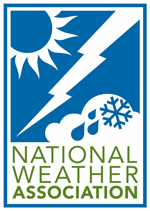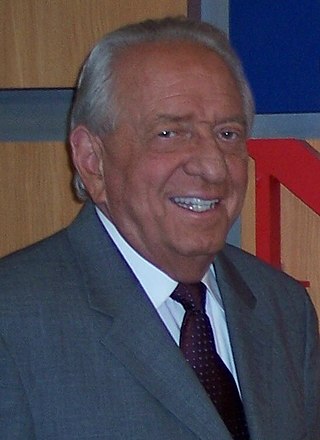The Carl-Gustaf Rossby Research Medal is the highest award for atmospheric science of the American Meteorological Society. It is presented to individual scientists, who receive a medal. Named in honor of meteorology and oceanography pioneer Carl-Gustaf Rossby, who was also its second (1953) recipient.

The American Geophysical Union (AGU) is a 501(c)(3) nonprofit organization of Earth, atmospheric, ocean, hydrologic, space, and planetary scientists and enthusiasts that according to their website includes 130,000 people. AGU's activities are focused on the organization and dissemination of scientific information in the interdisciplinary and international fields within the Earth and space sciences. The geophysical sciences involve four fundamental areas: atmospheric and ocean sciences; solid-Earth sciences; hydrologic sciences; and space sciences. The organization's headquarters is located on Florida Avenue in Washington, D.C.
Forensic meteorology is meteorology, the scientific study of weather, applied to the process of reconstructing weather events for a certain time and location. This is done by acquiring and analyzing local weather reports such as surface observations, radar and satellite images, other data, and eyewitness accounts. Forensic meteorology is most often used in court cases, including insurance disputes, personal injury cases, and murder investigations. This is most often the case when weather conditions were a possible factor, as in falldowns after snow and ice, wind, flooding, after aviation and nautical accidents, etc. With increasing losses from severe weather in recent years, the demand for forensic meteorological services has also grown. In the US, many forensic meteorologists are certified by the American Meteorological Society (AMS)'s rigorous Certified Consulting Meteorologist (CCM) program.

Kevin Edward Trenberth worked as a climate scientist in the Climate Analysis Section at the US National Center for Atmospheric Research (NCAR). He was a lead author of the 1995, 2001 and 2007 IPCC assessment reports. He also played major roles in the World Climate Research Programme (WCRP), for example in its Tropical Oceans Global Atmosphere program (TOGA), the Climate Variability and Predictability (CLIVAR) program, and the Global Energy and Water Exchanges (GEWEX) project.
Professor Sir Brian John Hoskins, CBE FRS, is a British dynamical meteorologist and climatologist based at the Imperial College London and the University of Reading. He is a recipient of the 2024 Japan Prize along with Professor John Michael Wallace in the field of "Resources, Energy, the Environment, and Social Infrastructure" for "Establishment of a scientific foundation for understanding and predicting extreme weather events". He is a mathematician by training, his research has focused on understanding atmospheric motion from the scale of fronts to that of the Earth, using a range of theoretical and numerical models. He is perhaps best known for his work on the mathematical theory of extratropical cyclones and frontogenesis, particularly through the use of potential vorticity. He has also produced research across many areas of meteorology, including the Indian monsoon and global warming, recently contributing to the Stern review and the IPCC Fourth Assessment Report.

Roger A. Pielke Sr. is an American meteorologist with interests in climate variability and climate change, environmental vulnerability, numerical modeling, atmospheric dynamics, land/ocean – atmosphere interactions, and large eddy/turbulent boundary layer modeling. He particularly focuses on mesoscale weather and climate processes but also investigates on the global, regional, and microscale. Pielke is an ISI Highly Cited Researcher.

Jule Gregory Charney was an American meteorologist who played an important role in developing numerical weather prediction and increasing understanding of the general circulation of the atmosphere by devising a series of increasingly sophisticated mathematical models of the atmosphere. His work was the driving force behind many national and international weather initiatives and programs.

The National Weather Association (NWA), founded in 1975, is an American professional association with a mission to support and promote excellence in operational meteorology and related activities.

Joseph Smagorinsky was an American meteorologist and the first director of the National Oceanic and Atmospheric Administration (NOAA)'s Geophysical Fluid Dynamics Laboratory (GFDL).

John Stewart Coleman was an American television weatherman. Along with Frank Batten, he co-founded The Weather Channel and briefly served as its chief executive officer and president. He retired from broadcasting in 2014 after nearly 61 years, having worked the last 20 years at KUSI-TV in San Diego.

Syukuro "Suki" Manabe is a Japanese–American meteorologist and climatologist who pioneered the use of computers to simulate global climate change and natural climate variations. He was awarded the 2021 Nobel Prize in Physics jointly with Klaus Hasselmann and Giorgio Parisi, for his contributions to the physical modeling of Earth's climate, quantifying its variability, and predictions of climate change.
Certified Consulting Meteorologist (CCM) is the title of a person designated by the American Meteorological Society (AMS) and CCM Board to possess the attributes of Knowledge, Experience, and Character as these pertain to the field of meteorology. Announced in 1957, the CCM program is a service for the general public by the AMS to establish high standards for those who provide advice in meteorology to the public. Forensic meteorologists are covered by this title and seal, similar to how broadcasters are recognized by the AMS as Certified Broadcast Meteorologists (CBMs).

Jagadish Shukla is an Indian meteorologist and Distinguished University Professor at George Mason University in the United States.
Weather, Climate, and Society (WCAS) is a peer-reviewed scientific journal published quarterly by the American Meteorological Society.

Eugenia Enriqueta Kalnay is an Argentine meteorologist and a Distinguished University Professor of Atmospheric and Oceanic Science, which is part of the University of Maryland College of Computer, Mathematical, and Natural Sciences at the University of Maryland, College Park in the United States.

Warren Morton Washington is an American atmospheric scientist, a former chair of the National Science Board, and currently a Distinguished Scholar at the National Center for Atmospheric Research (NCAR) in Boulder, Colorado.
Edward Epstein was an American meteorologist who pioneered the use of statistical methods in weather forecasting and the development of ensemble forecasting techniques.

Maria Janeth Molina is an American meteorologist. She was the on-air meteorologist for the Fox News Channel, a U.S. television network, from 2010 to 2016. As of 2022 she is an Assistant Professor in the Department of Atmospheric and Oceanic Science at the University of Maryland, College Park.

Elizabeth Austin is CEO and Founder of WeatherExtreme Ltd., a research and consulting firm.
Richard E. Hallgren is an American meteorologist. He is a former executive director of the American Meteorological Society (AMS) and has held several senior positions with the National Oceanic and Atmospheric Administration (NOAA), including the director of the National Weather Service, director of World Weather Systems and federal coordinator for Meteorological Services and Supporting Research. He directed the National Weather Service from 1979-1988 and was the executive director of the American Meteorological Society starting in 1988.














